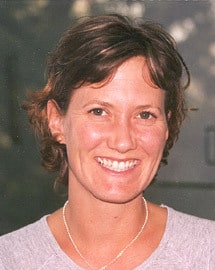Mountain Climbing, Altitude and LASIK
by David A. Wallace MD
People who enjoy the wilderness, and particularly those who do any significant amateur or serious climbing, have special needs relating to vision correction surgery. We present here a “case study” of one of our patients, followed by a discussion of the relevant factors that affect and pertain to this pursuit.
 Kelly B., age 30, Mountain Climber and Freelance Photographer
Kelly B., age 30, Mountain Climber and Freelance Photographer
Unaided Vision: Before LASIK: 20/800 each eye
Unaided Vision After LASIK: 20/15 each eye
Refraction Before LASIK:
Right Eye: -5.25 -1.25 x 180
Left Eye: -5.00 -2.00 x 175
FROM: Kelly B.
DATE: Mon, 23 Sep 2002
RE: Question for Dr. Wallace… High Altitude and LASIK
You performed successful and amazing surgery on my eyes a couple of years ago. I have had no problems with my new eyesight and am greatly appreciative of the procedure. However, since having my corrective surgery, I have ventured into the exciting domain of mountaineering (I have since moved from LA to Colorado). I have hopes of summiting high altitude peaks in the near future. To date, I have only climbed to 14,000 feet (with no eyesight problems), but have a trip planned to 18,000′ (Mexican Volcanoes) in November, then another trip to 22,500′ (Aconcogua) in February. I have been trying to research the effects of altitude on corrected vision with Lasik, but have not found any information (research indicates problems with RK surgery). Do you have any current information on studies of this nature? I’m REALLY hoping that my awesome surgery won’t cause any problems at high altitudes… please advise.
Thank you, and again… thank you Dr. Wallace for my perfect vision (well… at least here, at 9,500 feet!!!)
Kelly B.
—————————————————–
Dr. Wallace’s reply:
Hi, Kelly,
Glad to hear everything is going well for you in Colorado. You are correct; radial keratotomy (“RK”) can and did cause problems for one of the Everest climbers, Beck Weathers, which contributed to serious problems he encountered in the terrible ’96 season chronicled by John Krakauer’s Into Thin Air“. Weathers’ visual problems, along with other major errors in judgment, and brutally severe weather, led to numerous casualties that year on the mountain. Since then, intelligent climbers and trekkers have been wise to inquire about their own risk factors, and ask whether LASIK is different than RK in regard to altitude-related risk.
What was not well reported at the time (or since) was that Weathers had undertaken RK surgery something like one week before flying to Kathmandu and then Everest base camp. Apparently, he did not inform his eye surgeon about the imminent plans to climb Everest, nor did he advise his mountain guides that he had just received RK surgery. The short interval from surgery to altitude challenge certainly made things far worse than they might have been for him otherwise. The deep (and recent, incompletely-healed) corneal incisions of RK, combined with reduced partial pressure of Oxygen at high altitude, combined to cause fluctuation in corneal thickness and curvature. The net result of this for Beck Weathers was lousy vision and fluctuating clarity, two absolute “Bozo no-no’s” when it comes to mountaineering. Several years later, Weathers published his nightmarish experience in a book entitled Left for Dead: My Journey Home from Everest.
Thankfully, RK surgery is now obsolete, having been replaced by the much more accurate and stable methods of laser vision correction (LASIK and PRK). The radial, deep corneal incisions of RK have been eliminated in favor of very superficial laser sculpting as in the latter procedures.
You may also find solace in knowing that the partial pressure of oxygen at 29,000 feet is much lower than the partial pressure on either Anconagua (I think peaking at 22,500) or in the Mexican volcanoes which you say are in the 18,000+ range.
The other good news is that LASIK does not pose the same altitude hazard as RK, even shortly after surgery.
A friend and colleague of mine did a LASIK fellowship in Argentina in ’97, and his wife had LASIK there just before he finished his training. Two weeks later they went trekking in the Cordilliera Blanca, climbing to above 16,000 ft. He measured her vision and several other parameters, and published the results in one of the ophthalmology journals. She did fine, having no problems; not even any temporary blurring. She retained great vision, and they are still (happily!) married.
Have a great time, stay healthy, hike well and send us a postcard when you can! And keep enjoying that great vision.
Dr. Wallace
NOTE: Kelly had LASIK in August, ’00. Her referring optometrist informed me of that her vision after surgery was 20/15 in one eye and 20/20 in the other. She was, to say the least, extremely pleased with her vision, and that was before the correspondence noted above. We last heard from her in mid ’06, still very happy and still climbing! – DW